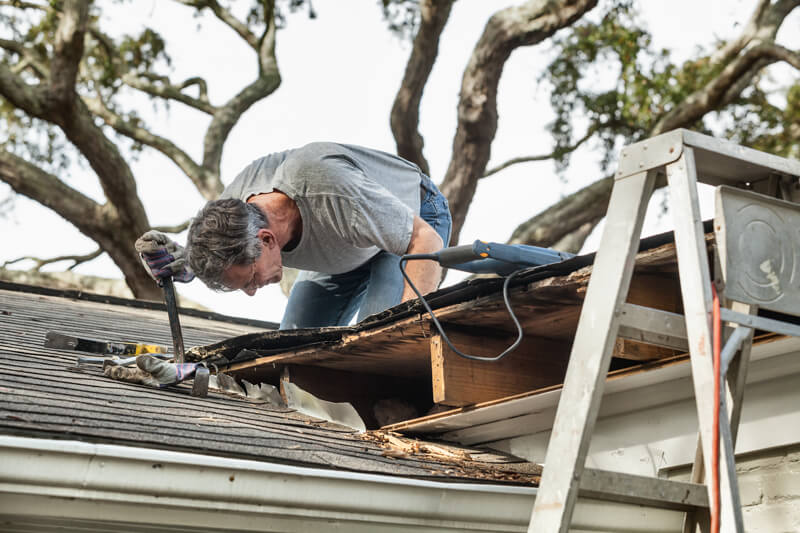Fascia Board Repair
Eaves are a susceptible part of your home that falling limbs and weather can damage. Fortunately, they aren’t too difficult to repair when the time comes, and repair is required. So, if your eaves are made of wood, and you have damage to your fascia board, let’s take a look at what to do.

Wood rot is the most common type of fascia board damage. This article discusses fascia board rot caused by water and how to prevent further fascia board damage. Gutter systems are designed to direct water into the gutters rather than behind them. Water is destroying your fascia board and entering your walls whenever it gets behind your gutters. When your fascia board rots to the point of becoming soft, it can no longer support the weight of the gutters. The gutter will eventually fall away from the house.
What Are Fascia Boards?
Fascia Board is a white trim board attached to your home’s roofing eave. Your gutters are attached to this board. Their primary function is to protect and cover the exposed rafters, preventing water from entering your walls. This gives the house a finished look while preventing insects, birds, squirrels, and other pests from entering.
Fascia is available in various sizes, including “one by six ′′, one by eight ′′, and “one by ten′′. You will need to measure your existing fascia boards to determine what size is required for your home.
Fascia is available in basically two different materials. Wood is the usual material since it is the least expensive and easiest to work with. Remember that any wood exposed to water will rot. As a result, you’ll need to paint the fascia with waterproof paint and sealant. Other options include composite fascia made of sawdust, wood chips, and epoxy resin. Alternatively, you could have your home’s wood fascia wrapped in vinyl or aluminum to protect and shield the wood. Fascia can be made of steel or aluminum in some commercial buildings.
A fascia board’s function is to keep moisture out of the structure while supporting the roof’s framework. It also gives the edge of the roof a clean, finished appearance. Furthermore, the fascia is the foundation of a robust and reliable gutter system. During heavy rain, the fascia bears the weight of the gutters and the large volume of water it holds. When the fascia is in poor condition, the gutter system is prone to sagging, causing water to spill over to the side and pool near the home’s foundation.
Bad Signs of Fascia Rot
Gutters installed incorrectly on the fascia board can potentially trigger water damage for various reasons. Water can enter through gutter seams, corner miters, and end caps. Water can overflow if the gutter becomes clogged. Water will not be contained in a gutter and cannot control the amount of water flowing from a high-volume area. When water overflows, it is directed to the front of the gutter. This is because the gutter is lower in the front. Despite this, some water still runs down the front of the end of the gutter and onto the fascia board.
Rotted fascia is easily noticeable. Examine peeling paint, discoloration, crumbling wood, and dangling gutters. Decayed wood starts to crumble easily and appears to be falling apart.
Gutters Leaning
When the fascia board becomes brittle, it can’t hold the weight of the gutters. The gutters will eventually fall off the wall. The gutter hardware (hidden hangers) in the example photo above is no longer biting into the fascia board. The fascia board behind the gutter is also discolored and rotting, as seen.
The gutters are in the process of falling off the house. If it does fall, you will almost certainly need to replace the gutter and the fascia board.
Gutters Falling Off
The fascia board is most likely damaged if you see a gutter hanging off the house. This situation will have a gutter half on the house and half hanging to the ground. A homeowner may attempt to attach a new fascia board to the old fascia board, which is entirely rotten. The fascia falls apart and rots away.
Gutters Keep Coming Loose
If you had a gutter re-secured because it was hanging loose, it came loose again a few weeks later… That fascia board is probably too soft and should be replaced. We see this all the time as a gutter company that does a lot of gutter repairs.
Moss on Fascia
This gutter has a lot of holes in the back. What has happened here is that they have re-secured the gutter several times, but it is still coming loose. The extra holes, as well as the mix of hangers of various styles, are dead giveaways. (gutter spikes, concealed hangers, self-tapping screws, and so on…) The reason for this is that the fascia board has sustained too much damage and can no longer support the weight of the gutter. You could install a gutter spike every 2 inches, but those spikes will eventually come loose.
You may also notice that the roof has no drip edge on the roofing eave. A drip edge is critical to your home’s gutter system and roofing eave. Its purpose is to keep water from under the shingles or behind the gutter. When there is no drip edge, the rain simply destroys it all.
Drip Edge is installed beneath the shingles and behind the gutter. It keeps water from backing up behind the gutters.
Fascia Visible Deterioration or Discoloration
The paint on fascia boards will peel off over time. Because the paint served as a protective layer, the wood is now susceptible to water damage. The discoloration is easiest to detect on whiteboards.
You can check your fascia boards by looking around your house perimeter every six months. Because the gutters are attached to the boards, you may only be able to see the bottom or top of the wood. Examine the exposed sections of wood for any signs of rot. One general rule of thumb is to use a screwdriver to poke the fascia. It’s still good if it’s solid. However, if your screwdriver penetrates the wood, the wood is becoming soft.
Cracks or splits in the wood, mold, moss, paint peeling, wet spots, and termites are all examples of fascia board damage. Because the gutter is attached to the board and higher, you may need a ladder to get a better look.
What Happens When Fascia Boards Rot?
Water and sun exposure are the primary culprits of soffit and fascia damage. Soffit and fascia boards subjected to these elements for an extended period may develop wet or dry rot. These boards may also crumble over time. Once the fascia board begins to rot, everything attached is at risk of falling. Fascia board is sometimes used to support the soffit installed beneath overhanging roofs. (as seen in the photos below) Because soffit is not present in all homes, it should not be used as a deciding factor.
When the fascia begins to deteriorate, the gutter is usually the first to fall apart. Because soffit is not present in all homes, it should not be used as a deciding factor. However, if you notice the soffit beginning to fall out in one section, have them check the fascia when reinstalling the soffit.
The gutter has already collapsed, leaving only the outer layer of what used to be the fascia board. Everything will have to be removed.
Is It Possible To Re-paint The Fascia Board?
The simple answer is “yes.” Fascia boards can be repainted if you detect them early enough before significant damage occurs. For it to work, the fascia must still be hard and solid. To accomplish this, you must altogether remove all gutter and fascia hardware. The following step would be to scrape away any loose paint. The fascia boards should then be painted with waterproof paint. (preferably pre-primed) Finally, after the paint has dried, you would reinstall the gutter system.
Rotting fascia boards is an irreversible process. Water has worn away and permeated the waterproof seal, leaving the wood vulnerable. Re-painting your fascia every few years will increase its life span.
The cost of removing and reinstalling the gutters and having a professional painter paint your fascia will be nearly as much as replacing the fascia wood itself. Re-painting your fascia isn’t always the best option if you’re not handy with tools or don’t have any friends to help you. That’s because repairing it will cost nearly as much (roughly 75% of the cost) as replacing it with all-new wood.
Can you Repair Damaged Fascia?
Fascia repair is not for the faint of heart. You never know how much rot and damage the fascia has sustained until you reach up and test it with a screwdriver. It can take time to replace a damaged fascia board. The issue is that you must remove all gutter and hardware attached to that section of the fascia board. Here’s a quick step-by-step guide for replacing a damaged fascia board. However, we do not recommend trying this unless you are confident in your abilities. Keep in mind that these are fundamental instructions that require some knowledge of measuring and cutting wood.
- Determine which area of the Fascia Board needs to be replaced. To determine what size is required, measure your existing fascia board.
- Paint your fascia with water-resistant paint to prepare it.
- While the paint dries, remove all gutters and brackets from the existing fascia.
- Remove any nails and unscrew all hardware from the fascia board’s face.
- Take the fascia board off the wall.
- Remove debris, caulk, paint, or other materials from the rafters that prevent the fascia from flushing with the boards.
- Begin at one end and screw your first section of the fascia into the rafters (ensure it’s square and straight).
- Begin at one end and screw your first section of the fascia into the rafters (ensure it’s square and straight).
- Install the fascia from top to bottom. Make sure to attach yourself to every rafter.
- Use all the factory edges, so you only have to cut the last board. To ensure a proper connection, make sure the previous board spans at least 3-4 rafters.
- You can reinstall the gutter system once your fascia is appropriately installed. Make sure the gutters are angled correctly towards the downspouts.
Of course, if you want to avoid having to do more fascia repair in the future, repaint the “good” fascia and soffit to keep them from deteriorating.
Final Word
Fascia board is an essential component of your gutter system and roofing eave. To get the most longevity out of these boards, keep an eye on them and act quickly if you notice signs of damage. Remember that rotting wood cannot be repaired. It’ll have to be replaced.
Throughout the year, you should inspect your gutter system to ensure it is not damaged. It is advised that you clean your gutters at least twice a year. You can regularly check your fascia board and gutters while cleaning them to help make sure the seams and corners are sound and functional. Gutter neglect is the leading cause of all gutter system problems. If debris accumulates in your gutter, water may leak behind the gutter and damage the wood.
Our customers appreciate that they can work with a single company for all their gutter, trim, and fascia needs. Trust Texas Gutter King for quality work at reasonable prices, whether you’re changing your color palette or safeguarding exposed wood from severe weather.
If time or moisture has taken its toll on your trim and fascia, our experts can provide prompt fascia repair services to keep your home safe. Contact us or fill out our online form for a FREE quote on trim and fascia repair services.
